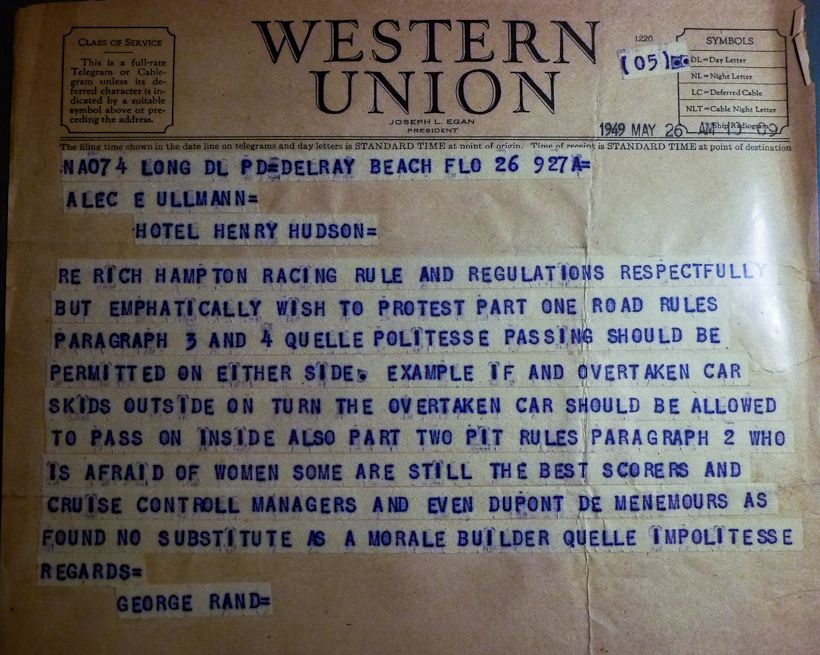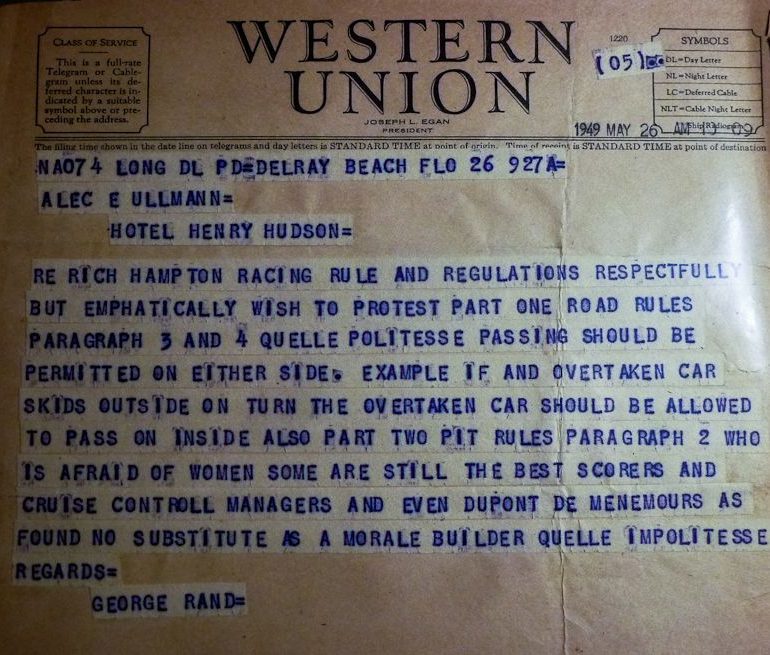By Rick Carey, Auction Editor

“Paper”, in the collector sense, is a term that describes the original, physical, written, history of an object.
Most times “paper” is a mundane succession of registrations and titles, records that describe a car’s ownership history. “Paper” in that sense may translate to “provenance”, the succession of recognized collectors and museums through which it has passed and reinforce its – in our case a car’s – recognition over many years as valuable or significant.
But there is other “paper”, notably the three boxes of Sebring race records from the files of Sebring founder and impresario Alec Ulmann that were offered by Bonhams at their “Preserving the Automobile” auction at the Simeone Museum in Philadelphia on October 7, 2013.
There was wonderful stuff among the Ulmann lots. His Hispano-Suiza records sold for $7,500. A 1940 ARCA road racing regulations brochure, the foundation of road racing in the U.S., brought $475.
But for followers of racing history and Sebring junkies the choice lot was #264, described as “A large quantity of Sebring related archives and programs.”
It was three boxes full of old programs (some still twine-wrapped from the printer), regulations brochures; a box full of old paper – letters, telegrams, drafts of entry lists – copies of unobtainable old time sheet booklets from the Fifties, and more, with a pre-sale estimate of $1,000-$2,000.
Reviewed circumspectly, before the sale, they were the crown jewels of the offering.
How often do the original communications between organizers, sanctioning bodies, the race site and entrants become available? How many even survive in some family’s storague unit of grandpas or grandmas letters?
The Ulmann files contained flimsy old onion-skin air mail letters, fragile carbon copies that might disappear with a sneeze. It was scary just to touch them: irreplaceable letters and telegrams stuffed into files, curled and folded.
Maybe you get the idea. It is the history of America’s first international road race, on paper.
I bought them.
‘Twasn’t easy. Freelance writers don’t have deep pockets. This was a campaign, a fraught campaign.
Sold deep in the Ulmann section of the auction, Rupert Banner opened the bidding with a commission bid (i.e., an absentee bidder who’d placed an opening and high bid before the sale) of $1,000. Bids came from throughout the Simeone Museum.
I raised my paddle early. Rupert recognized me as the default bidder, but kept looking down to the commission bid and quickly raising. The room dropped out at the $2,000 commission bid.
I would have like to have stopped there, too, but it went on:
$2,200 me.
$2,500 commission bidder
$2,800 me.
$3,000 commission bidder.
Agony, angst, how do I ‘splain spending this much to my wife and life partner? Curl up like a snail, cover my eyes and … raise my paddle one more time for $3,200 (uh, not quite all, there was the buyer’s premium and Philadelphia sales tax, $4,320 total.)
Rupert Banner: “The commission bidder is out. Are there any more bids? Anyone in the room?”
Wait, wait … Rupert dropped the hammer.
I’m not ashamed to say that I raised my arms like the winner of a marathon, my bidder number high in the air.
I threw the boxes into the boot of my Pontiac GTO and arrived home at 11:30PM, then stayed up ‘til nearly 2AM pawing through the booty. I giggled like a schoolboy. It is marvelous:
- A lifetime supply of 1963 Sebring programs
- Several original letters from Ferrari signed in lavender ink
- 1956, ’57 and ’58 time sheets recording the lap times of every car on every lap
- A marvelous 1949 telegram from George Rand contending with Triple A’s refusal to allow women in pits
- Annotated original Sebring entry lists
- A sequence of 1963 correspondence about CSI horsepower/weight formulas for GT cars and the competitiveness of Cobra GTs and the Corvette Grand Sports
- More and more.
It’s a segment of the early history of road racing in America, reduced to anecdotes from the original players. It just doesn’t get any better.
The challenge now is to preserve this irreplaceable archive of original documents, make it available to historians and recover at least some of my investment.
I’ve confessed to Ellen (wife and life partner) and it’s OK.
The story isn’t over. In fact, it’s just begun, but it’s a whole new window on what Alec Ulmann and his team at Sebring went through that will, I hope, illuminate early American road racing history.
This is more than “paper”, it’s history.
I shiver when I think what I have, and what I have to do to preserve and make sense of it so it isn’t lost.
[Source: Rick Carey]





